Abstract
Commercial progress concerning biobased materials has been slow, with success depending on functionality and emotional responses. Emotional interaction research provides a novel way to shift perceptions of biobased materials. This study proposes a human-centered emotional design framework using biobased tea waste to explore how sensory properties (form, color, odor, surface roughness) shape emotional responses and contribute to sustainable wellbeing. We used a mixed-methods approach combining subjective evaluations (Self-Assessment Manikin scale) with physiological metrics (EEG, skin temperature, pupil dilation) from 24 participants. Results demonstrated that spherical forms and high surface roughness significantly enhanced emotional valence and arousal, while warm-toned yellow samples elicited 23% higher pleasure ratings than dark ones. Neurophysiological data revealed that positive emotions correlated with reduced alpha power in the parietal lobe (αPz, p = 0.03) and a 0.3 °C rise in skin temperature, whereas negative evaluations activated gamma oscillations in central brain regions (γCz, p = 0.02). Mapping these findings to human factors engineering principles, we developed actionable design strategies—such as texture-optimized surfaces and color–emotion pairings—that transform tea waste into emotionally resonant, sustainable products. This work advances emotional design’s role in fostering ecological sustainability and human wellbeing, demonstrating how human-centered engineering can align material functionality with psychological fulfillment.
1. Introduction
Currently, due to increasing environmental problems and resource scarcity, the development of biobased materials has become a global concern. Researchers and policymakers emphasize the use of biobased materials due to their renewability, environmental friendliness, and potential low carbon footprint [1]. Studies have shown that biobased materials reduce dependence on fossil fuels and provide performance advantages comparable to traditional materials in many applications. Thus, scholars consider biobased materials the core materials for building a recycling-oriented society in the 21st century [2].
However, despite significant research progress, the performance of biobased materials in commercial applications still needs improvement. Decades of fruitful results have accumulated in this field; however, these materials are still in their early stages of development in terms of commercial applications [3]. Researchers have mainly focused on enhancing the functional properties of biobased materials, such as strength, durability, and sustainability. However, market performance and user acceptance are often overlooked. The current market situation shows that people generally negatively perceive products based on biobased materials, considering their poor quality, low cost, and lack of durability [4]. This cognitive barrier limits the widespread application of biobased materials in commercial fields and poses a challenge to their future development [5].
In promoting the commercialization of biobased materials, some scholars suggest using certain biobased materials to replace synthetic materials to achieve sustainable development goals. Understanding consumer emotional responses is a crucial step in this process [6]. Human factors engineering, an interdisciplinary research field, offers a range of methods and tools to study and optimize the interactions between consumers and products, systems, and environments [7]. It investigates emotions through various means, including physiological measurements, behavioral observations, and subjective reports. Physiological measurement techniques, such as electroencephalography, skin conductance, heart rate variability, and eye tracking, provide objective data on consumer emotional responses. These physiological indicators can reflect emotional changes when consumers encounter and use biomass material products, helping researchers identify which product characteristics trigger positive or negative emotional responses.
In today’s competitive market environment, the commercial success of biobased materials relies on enhancing technical performance and understanding the emotional needs of consumers. Emotion research based on human factors engineering is crucial in this regard [8]. In this context, emotion research offers an innovative approach to changing people’s perceptions of biobased materials. By analyzing people’s emotional responses to biobased materials, we can identify and improve material components that trigger negative emotions and change the stereotype of biobased materials as “poor quality, cheap, and non-durable”, increasing market acceptance. Existing studies have better understood people’s concerns, expectations, and needs by analyzing their emotional responses to materials [9,10]. Existing research has confirmed that emotion research, via physiological measurements and behavioral observations, optimizes product design, enhancing user experience and brand loyalty [11]. This emotional analysis reveals consumers’ feelings about the products and provides a solid basis for formulating marketing strategies. Drawing on emotion research, companies can design products and brand images that resonate more with consumers and accurately target markets, significantly boosting competitiveness [10].
This approach not only echoes the principles of emotional and affective design but also aligns with a broader paradigmatic shift in contemporary design theory, particularly the rise of metamodernism [12]. Metamodernist design emphasizes post-ironic sincerity, hope, ecological interdependence, and emotional complexity, all of which are deeply relevant to the study of sustainable wellbeing and bio-based aesthetics [13]. Acknowledging this theoretical context highlights the ontological significance of working with biobased materials, positioning them not just as eco-friendly substitutes but as active agents in meaning-making and world-building practices.
Additionally, emotion research can reveal emotional attitudes toward eco-friendly products, aiding companies in formulating more effective marketing strategies and supporting sustainable development goals [14]. Systematic emotion research is expected to provide scientific evidence for policymaking and industry standards, promoting the healthy development of the biobased materials industry. Therefore, emotional research in human factors engineering is indispensable in the commercialization of biobased materials.
There are a few examples of applying human factors engineering techniques to study the emotional value of biobased materials. The initiative of material-driven design was previously proposed [15], arguing that people’s perception of material properties is a crucial factor influencing consumer evaluations [16]. The success of new materials in the marketplace depends on their functionality and how they make people feel. Recent studies have shown that product appreciation derives, in part, from its material properties, which define the object’s appearance and generate an emotional response that influences purchasing behavior [6]. Thus, the role of materials in sensory, expressive, and emotional dimensions is becoming an important area that influences the practical application of materials. Research on material surface features related to emotions has developed into a relatively mature field of research, especially in Europe and the United States, where human factors engineering techniques are widely used. For example, the studies in [17,18] required their subjects to observe and touch the surfaces of materials, such as wood, leather, fabrics, etc., and synchronously recorded the physiological indicators of the participants, such as electroencephalography (EEG) and electrodermal signals. Thus, the influence of the surface characteristics of the materials on the subjects’ emotions was analyzed. Although no studies have explicitly focused on the emotional aspects of biobased materials, relevant prior work provided many methodological references for this study.
Although researchers have made some progress in all aspects of biomass material research, the emotional value dimension—especially its relevance to product form and user perception—remains underdeveloped. Overall, studies focusing on the emotional aspects of biobased materials are mainly based on human subjective evaluation and have yet to be combined with human factors engineering technology to conduct more accurate quantitative research. For example, researchers have mainly focused on quantifying human psychological indicators when studying the emotions evoked by materials [19]. In contrast, the integrated study of physiological and psychological indicators still needs to be developed in depth [20]. Although some scholars have also used human factors engineering technology to conduct research, there are challenges in terms of practical applications. The experimental objects are often presented on a single, flat surface, and researchers focus more on the effects that materials (e.g., wooden boards, sheet fabrics, stone slabs, etc.) have on emotions in a flat state than when the materials take on various forms, such as manufactured products. Since the variable of form itself strongly influences emotion [21], the results of this research are not directly applicable to the product development stage. Translating the results of laboratory research into market applications still needs to be further explored.
In summary, research on the emotional value of biobased materials, underpinned by human factors engineering technology, has a bright future. The key to unlocking this potential lies in strengthening interdisciplinary cooperation and harnessing the power of modern scientific and technological tools. By doing so, researchers and companies can make significant breakthroughs in this field, leading to the successful commercialization and sustainable development of biobased materials. This is also a key feature of this study, which emphasizes the multimodal comprehensive evaluation of the physiological and psychological responses of biobased materials in the context of more morphological variables related to the product and promotes this research result to bridge the gap between laboratory results and market-level design practices.
This study expects to achieve the following objectives:
- Emotion measurement and data collection:For the subjective emotion evaluation measures, the subjects self-reported their emotional state after using biobased materials, and their emotional responses were objectively quantified in combination with physiological indicators.
- Multimodal data analysis:This analysis was conducted to reveal the characteristics of subjects’ emotional responses when using different biobased materials.
- Strategy development to enhance market acceptance:This was conducted for product design optimization and the development of product design strategies based on emotional value to enhance the market attractiveness of biobased materials and improve consumer loyalty.
Figure 1 shows the research process applied in this study. First, we investigated the mechanisms of how materials affect subjective emotions. Through our experimental design, we utilized the Self-Assessment Manikin (SAM) scale (Bradley and Lang, 1994) to evaluate the subjective emotions of the participants [22]. We collected subjective emotion reports from subjects in different biomass material environments and established emotion labels. Statistical analysis methods were used to determine the relationship between material characteristics and emotional responses. Then, we conducted emotion analysis based on multimodal fusion. Due to the complexity of emotions, a multimodal research method combining the central and peripheral nervous systems can be used to more effectively classify emotions [23]. Therefore, we simultaneously measured physiological indicators of the central and peripheral nervous systems. Specifically, we planned to use wearable physiological measurement devices to collect various physiological data generated by subjects during the use of biobased materials in real time, including EEG, electrodermal activity (EDA), electrocardiography (ECG), electromyography (EMG), electrooculography (EOG), skin temperature (SKT), and respiratory signals (RESPs). The integration of various types of physiological data enhances the accuracy of emotion recognition. Statistical analysis methods were used to assign the emotion labels to the experimental samples and establish the relationship between the subjective evaluations and physiological emotional responses. Finally, based on the experimental results, we discussed the relationship between material composition and subjective and physiological indicators and explored the influence of material composition elements on psychological and physiological emotions. We formulated targeted product design strategies to enhance the market competitiveness of biobased materials.
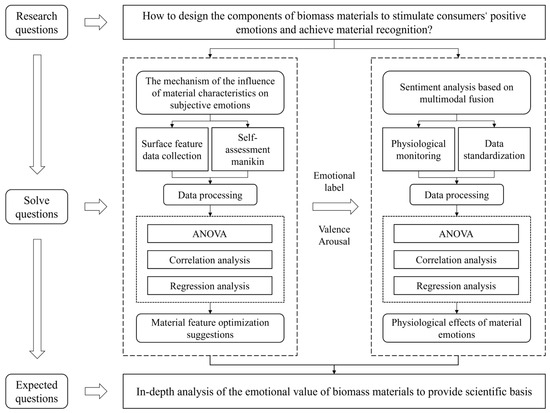
Figure 1.
Study flow chart.
2. Method
2.1. Participants
Regarding the number of participants, relevant research suggests that at least 10 subjects are needed to obtain statistically significant results [24]. Furthermore, this study in [24] found that the most commonly used range of study participants is 10–30. Additionally, after reviewing recent studies on emotional research [17,23,25,26], we ultimately recruited 24 university students (16 men and 8 women) to participate in the emotional stimulation experiment. Their ages ranged from 18 to 25 years. All of them had normal or corrected-to-normal vision, no tactile impairments or history of neurological disorders, and normal olfactory function. To ensure data accuracy, we required all participating students to abstain from alcohol and caffeine and stay up late 24 h before the experiment. We informed each participant about the necessary procedures and had them sign a consent form. This study was conducted in accordance with the Declaration of Helsinki and approved by the Research Ethics Committee of Shantou University (Ethics Approval Number: STU202406002).
2.2. Experimental Samples
This study selected tea stems from green tea, Tieguanyin, and Wuyi rock tea as the experimental materials based on their renewability, environmental impact, color, morphology, and olfactory characteristics [27,28,29,30,31,32]. Tea stems, rich in bioactive components and possessing unique mechanical properties, are considered a potential resource for transformation into high-value-added products. Tea stems were processed into fiber and powder forms during the experiment and combined with jelly wax to create samples of various shapes and colors (Details are in Appendix A). Through systematic analysis by a sensory evaluation team, we categorized the samples based on their performance in color, shape, odor, and surface characteristics to explore the potential impact of tea aroma and morphological characteristics on emotions (material details are in Appendix B and Appendix C). The specific classification criteria include material shape (flat, curved, and spherical), color (green, black, yellow, and red), intensity of odor (strong, medium, and light), and surface roughness (very smooth, smooth, slightly smooth, slightly rough, rough, and very rough).
2.3. Experimental Environment
The experimental setup is shown in Figure 2 (see on-site photos in Appendix D). To ensure accuracy and consistency, we used air conditioning in the laboratory to maintain the temperature and humidity, keeping the room temperature at 22 ± 2 °C and humidity at 40 ± 10%. Stable environmental conditions helped to minimize external interference with the experimental results. For ease of observation and evaluation, we placed the experimental samples on an observation board inclined at a 45° angle, where all subsequent experiments were conducted. This setup allows the samples to be presented to the participants, ensuring an optimal viewing angle.
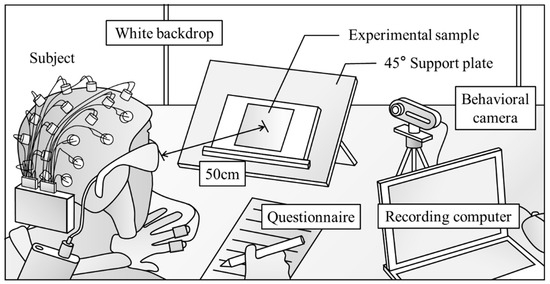
Figure 2.
Schematic diagram of the experimental environment.
Additionally, to prevent visual distractions, we arranged whiteboards around the table to provide a uniform background and reduce attention dispersion. During the visual and tactile evaluation parts of the experiment, the participants sat approximately 50 cm from the observation board. An experiment assistant sat next to the participant, who was responsible for recording data and distributing the experimental samples. A recording computer was placed next to the observation board for the experiment assistant to synchronously record and monitor the participants’ physiological data during the experiment, as it appears in Figure 2.
2.4. Subjective Emotional Evaluation
We used the SAM scale to measure participants’ subjective evaluations of the experimental samples (Figure 3). The SAM scale is presented in an image format, allowing participants to conduct self-assessments of emotions through visual stimuli [33]. This dual-dimension evaluation method enables us to comprehensively understand participants’ emotional responses and physiological responses when interacting with different experimental samples, providing a detailed analytical basis for the experimental results. The intuitive design of the SAM scale allows participants to express their emotional states more accurately, ensuring the accuracy and reliability of the data.
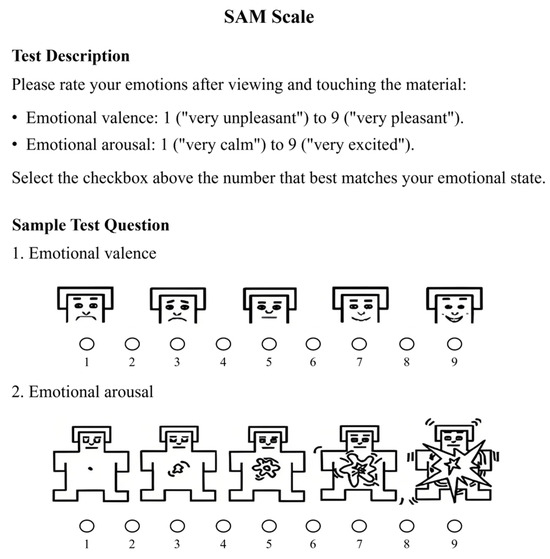
Figure 3.
SAM Scale.
The scoring method references the approach used in [6]. In the 9-point grid used to assess valence, one end shows a happy face and the other shows a sad face, with 9 indicating pleasant, 5 indicating neutral, and 1 indicating unpleasant. This design effectively captures the amplitude of emotional responses. Additionally, to assess changes in arousal, the SAM scale uses another 5-point grid, with one end featuring an image of an explosion, symbolizing high emotional arousal, and the other featuring a dot, representing weaker emotions (ranging from 5 for strong to 1 for weak).
2.5. Physiological Measurement Indicators and Equipment
To obtain physiological data that reflect emotions accurately and effectively, this study simultaneously measured EEG indicators, representing changes in central nervous system activity, as well as peripheral-nervous-system-related physiological indicators. The dataset consists of 29 features, including 15 EEG channels and 14 peripheral physiological channels (2 for EDA, 7 for ECG, 1 for SKT, 3 for EOG, and 1 for RESPs).
EEG is a commonly used method for monitoring the central nervous system [34]. According to the literature [35], human emotions can be classified using EEG data collected from different regions of the brain, including the four brain lobes (frontal, parietal, temporal, and occipital) and four hemispheric regions (left frontal, right frontal, left parietal–temporal–occipital, and right parietal–temporal–occipital). However, research indicates that the frontal lobe stores more information about emotional states [24]; the importance of other regions cannot be excluded. Researchers advocate focusing on the sub-regions of the brain to fully understand the complexity of emotions [35,36]. For example, the authors in [37] found that the left hemisphere is associated with positive emotions while the right hemisphere is associated with negative emotions. Moreover, the studies in [38,39] suggest that the frontal lobe triggers the temporal and occipital lobes to trigger surprise, happiness, and disgust, and the parietal lobe triggers sadness. Therefore, different brain regions contribute differently to emotions. In this study, we focused on all four brain regions to comprehensively understand the impact of materials on participants’ emotions.
In our experiment, we relied on the ErgoLAB EEG wearable device, a highly reliable tool provided by Jing Fang Technology (Beijing, China), to collect EEG data from the participants. The 15 electrode positions, as shown in Figure 4, were strategically distributed according to the international 10–20 system across the frontal (F3, F4, and FPZ), occipital (C3, CZ, C4, PZ, P3, and P4), temporal (F7, F8, P7, and P8), and parietal lobes (O1 and O2). This emphasis on the ErgoLAB device underscores the reliability of our data collection process.
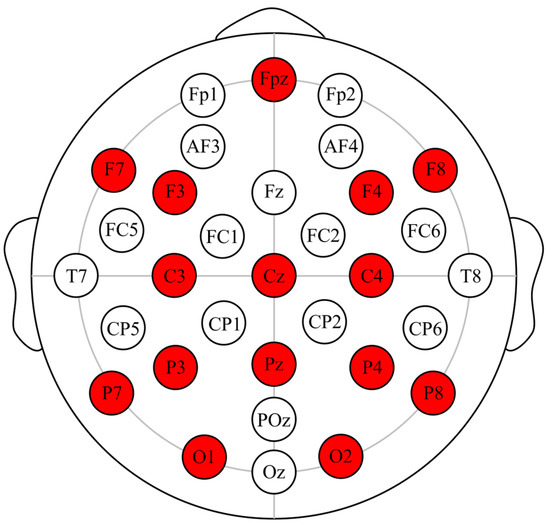
Figure 4.
Electrode positions.
Moreover, the authors in [24,40] indicate that alpha, beta, and gamma waves have higher discriminative power in terms of emotion classification along the valence and arousal dimensions. Alpha waves are typically associated with relaxed mental states and brain activation, beta waves are related to active and highly focused states, and gamma waves are linked to intense brain activity. Delta waves are the slowest and associated with non-rapid eye movement sleep, while theta waves are related to subconscious activities such as dreaming and meditation [41]. Based on existing research, we only studied alpha, beta, and gamma waves to achieve optimal accuracy in emotion measurement.
In terms of peripheral physiological data, research indicates that EDA, ECG, SKT, EOG, and RESP play crucial roles in emotion research. Specifically, skin conductance levels (SCLs) and skin conductance responses (SCRs) in EDA are used to assess emotional arousal [42,43,44]. Analyzing emotional states by ECG primarily involves time-domain and frequency-domain features of heart rate variability (HRV). Time-domain features include heart rate (HR), the standard deviation of normal-to-normal intervals (SDNNs), the root mean square of successive differences between adjacent R–R intervals (RMSSDs), and the percentage of differences between adjacent regular intervals more significant than 50 ms (pNN50). Frequency-domain features include low-frequency power (LF), high-frequency power (HF), and their ratio (LF/HF) [45]. These features provide a physiological basis for understanding the relationship between cardiac activity and emotional states and, through analysis, can be used to assess emotional states and the activity levels of the autonomic nervous system [46,47].
Additionally, the study in [48] shows that extracting blink count, saccade count, and pupil diameter from an EOG can distinguish between positive and negative emotions. Moreover, the study in [49] points out that SKT changes with emotional states, and the respiratory rate from RESP can also reflect emotional states [50]. For example, slow breathing is associated with relaxation, while irregular, rapidly changing breathing is linked to intense emotions, such as anger or fear.
To collect peripheral physiological data, an ErgoLAB wearable wireless physiological recording module was used, as provided by Jing Fang Technology (Beijing). The specific equipment included the ErgoLAB EDA wireless electrodermal sensor, ErgoLAB PPG wireless pulse sensor, ErgoLAB Chest Biosensing smart wearable chest strap sensor, and Tobii Pro Glasses 3 wearable eye tracker. The data relating to eye movement, physiological, and EEG measurements were meticulously and synchronously analyzed using the analysis module of the ErgoLAB human–machine environment synchronization platform, ensuring the accuracy and reliability of the results.
2.6. Experimental Procedure and Data Processing
Participants were guided into the lab and began by filling out a personal information form, including age, gender, health status, and an informed consent form. After collecting these forms, the assistant explained the experiment’s procedures and helped the participant with the data collection equipment. Once properly equipped, the experiment commenced. The formal experimental procedure is shown in Figure 5. The formal procedure involved moving participants from the preparation to the experimental area, where various samples were evaluated. The assistant managed sample changes, distributed subjective scales, and recorded physiological signals. Participants were instructed to rest with their eyes closed for 2 min to stabilize baseline data. Then, they observed, touched, and smelled each sample for 10 s, followed by completing an emotion scale. After each sample experience, participants will close their eyes and rest for 30 s before starting the next sample experience. This process was repeated for all 24 samples, with recordings stopped after completion. To prevent bias, participants were unaware of the names or origins of the materials. All physiological recordings were initiated using the ErgoLAB wearable wireless physiological recording module, which synchronized the start of data collection with the specific gesture shown on the behavior camera. This gesture serves as a clear boundary point to ensure that in the later data processing process, by checking the corresponding sample experience process recorded in the video, the subjective questionnaire data and physiological data time points can be consistent.
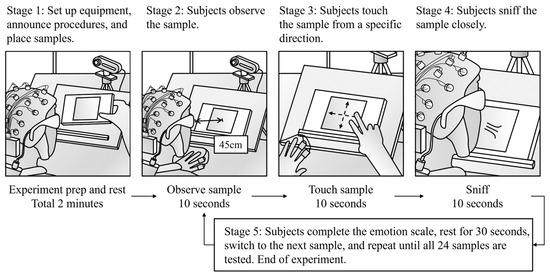
Figure 5.
Experimental flow chart.
For data extraction and processing, subjective data, including valence and arousal levels from the SAM scale, were recorded and averaged for each sample. We analyzed emotions in a two-dimensional arousal–valence space to identify significant evaluative differences. Correlation and regression analyses examined how sample components influenced evaluations, utilizing SPSS 22.0 with a significance level 0.05 and Bonferroni correction for comparisons.
We reviewed physiological data to exclude unusable segments and extracted usable data into 24 segments per participant. We removed artifacts from the EEG by using the last 10 s of the 30 s rest period before each sample as the pre-stimulus control baseline. This helped correct the physiological data recording during the 30 s stimulation period of the formal sample experience, ensuring accuracy. We then calculated the average power data for alpha and beta waves. For EDA data, we calculated the average SCL and SCR values and subtracted the baseline data. We filtered ECG data to reduce noise while preserving effective signals. To minimize noise, we preprocessed other physiological data (SKT, RESP, EOG) using ErgoLaB software(ErgoLAB 3.0).
3. Experimental Results
After conducting the experiment, we systematically analyzed the collected data from three perspectives: subjective emotional evaluations, EEG-based emotional responses, and peripheral nervous system activities. This chapter presents the results of these analyses in detail. First, we explore the distribution of subjective emotional ratings and their relationships with material properties. Next, we investigate the neural correlates of emotions through EEG analysis, examining both emotional effects and the predictive relationship between EEG features and subjective emotional states. Finally, we examine the emotional responses reflected in peripheral physiological indicators and assess their predictive power for subjective emotional states. These findings provide a comprehensive understanding of how material perceptions are linked to emotional responses across multiple physiological and psychological dimensions. The specific structure of the experimental results is shown in Figure 6.
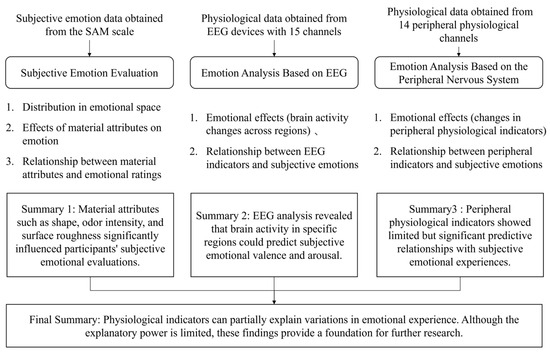
Figure 6.
Summary of experimental results.
3.1. Subjective Emotion Evaluation
3.1.1. Subjective Emotional Space
Figure 7 shows the distribution of scores for the 24 experimental samples in the arousal–valence two-dimensional emotional space. Based on the distribution of samples shown in Figure 7, we attempted to perform a subjective analysis from a visual perspective. Although a few dark-colored samples (green and black) are in the low valence and high arousal quadrant, overall, lighter-colored samples with higher brightness (yellow and red) are primarily concentrated in the high valence and high arousal quadrant. In contrast, dark-colored samples mostly appear in the low valence and low arousal regions. From the subjective analysis results, samples with spherical and curved shapes and higher brightness colors (yellow and red) tend to receive higher scores.
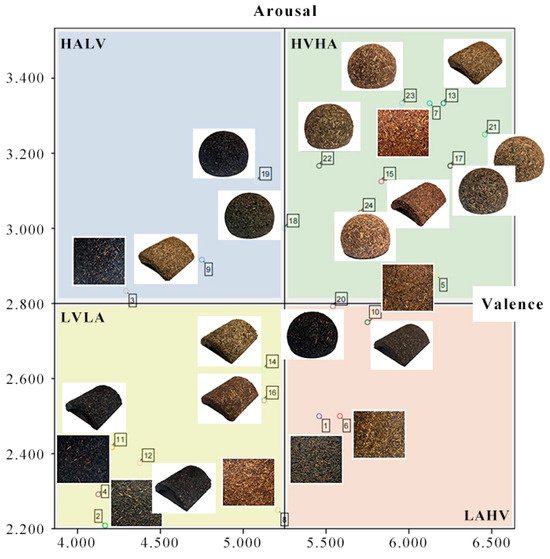
Figure 7.
Subjective emotional space.
Based on Russell’s arousal–valence two-dimensional emotional space [51], we assigned emotion category labels to the 24 experimental samples. Among 24 samples, 63% were labeled as ‘Happy’ (high valence/arousal), primarily spherical and yellow/red, while ‘Disappointed’ samples (21%) were flat and dark-colored (Figure 7).
3.1.2. Differences in Subjective Evaluation of Material Components
The analysis of variance shown in Table 1 indicates that shape, color, odor intensity, and surface roughness significantly affect valence and arousal. Specifically, spherical shape, yellow color, light odor, and very rough surface characteristics received the highest scores in valence and arousal (Figure 8).

Table 1.
Results of variance analysis of material components.
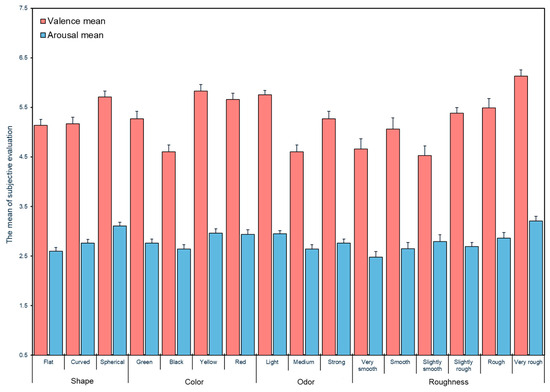
Figure 8.
The result of the subjective emotional score.
These results reveal how subtle variations in material characteristics can significantly influence emotional experiences. Spherical samples can elicit more positive emotional responses due to their excellent visual and tactile appeal and intrigue. The higher scores for yellow samples can be attributed to the fact that bright colors are typically perceived as vibrant and attractive, potentially enhancing emotional arousal and positivity. Mild odors tend to be comforting, whereas strong odors may lead to discomfort and negative emotions. Finally, the significant impact of surface roughness suggests that samples with very rough surfaces score higher in both valence and arousal than smooth surfaces. Although previous studies have shown that materials with higher roughness will generate unpleasant emotions when touched [52]. However, when comparing various materials for perception experiments, it was also found that both velvet and plastic materials are very smooth, but excessively smooth plastic may cause disgust due to its “unnatural feeling” [53]. This proves that samples with rougher surfaces are more in line with people’s impression of the natural form of materials. This rough texture may provide richer tactile feedback, enhancing emotional arousal and fostering positive emotional responses.
3.1.3. Relationship Between Material Components and Subjective Evaluation
To examine the relationship between material components and subjective evaluations, we used regression analysis to assess the impact of each variable on valence and arousal. Stepwise regression identified shape type and surface roughness as key predictors of valence, with an R2 value of 0.105, explaining 10.5% of the variance. The model passed the F-test (F = 33.665, p < 0.05) and is represented by the equation: Valence = 3.627 + 0.289 × Shape Type + 0.294 × Surface Roughness. Multicollinearity checks showed VIF values below 5, and the Durbin–Watson value was close to 2, indicating no multicollinearity or autocorrelation issues. The analysis showed that both shape type (β = 0.289, t = 3.515, p < 0.01) and surface roughness (β = 0.294, t = 7.428, p < 0.01) had significant positive impacts on valence.
For arousal, in Table 2, shape type and surface roughness were identified as key predictors, with an R2 value of 0.081, explaining 8.1% of the variance in arousal. The model passed the F-test (F = 25.352, p < 0.05) and is represented by the equation: Arousal = 1.804 + 0.256 × Shape Type + 0.131 × Surface Roughness. VIF values were below 5, and the Durbin–Watson value was close to 2, indicating no multicollinearity or autocorrelation issues. The regression coefficients showed significant positive impacts of shape type (β = 0.256, t = 4.896, p < 0.01) and surface roughness (β = 0.131, t = 5.189, p < 0.01) on arousal. These findings highlight the importance of shape and surface texture in influencing valence and arousal, suggesting that optimizing these factors can enhance product value and user experience, leading to greater satisfaction and engagement. This is especially true for natural materials, as their unique ecological significance and associated rough textures (such as bark, rocks) may evoke positive associations with natural shelters or resources, but attention should also be paid to the potential decrease in potency due to tactile discomfort [54]. Therefore, it is necessary to conduct corresponding research to find the correct mechanism by which the shape and surface texture of natural materials affect valence and arousal.

Table 2.
Stepwise regression results of subjective valence and arousal.
3.2. Emotion Analysis Based on EEG
In this section, we will use the emotion categories obtained from Table 1 as grouping variables and the EEG data from various frequency bands as test variables. We will conduct a one-way ANOVA to analyze whether EEG data have significant differences across different emotion categories. Additionally, we will use subjective valence and arousal as dependent variables and perform a stepwise regression analysis to examine the influence of EEG data on subjective evaluations.
3.2.1. Emotional Effect
From Table 3, one-way ANOVA was used to study the differences in 16 alpha, beta, and gamma band EEG components across different emotion categories. The results show that samples with different emotion categories exhibit significant differences in αPz, αO1, βPz, γCz, γC3, and γPz (p < 0.05).

Table 3.
ANOVA results of different emotion categories in the EEG band.
From Figure 9, at the αPz and αO1 sites, negative emotions such as Nervous and Disappointment showed higher values than Happy, indicating an increase in α wave activity as emotions shift from positive to negative. Similarly, βPz values increased when emotions shifted from Happy to Nervous, although they decreased moving from Nervous to Disappointed, suggesting higher beta activity associated with negative emotions. Significant differences were noted for γCz, γC3, and γPz sites, with Disappointed emotions exhibiting higher values than Happy, highlighting increased gamma activity with negative emotions. Overall, the data suggest that as emotions transition from positive to negative, EEG activity across these channels increases, reflecting heightened emotional arousal and cognitive processing.
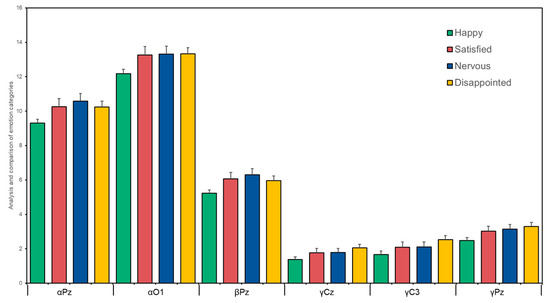
Figure 9.
Analysis and comparison of emotion categories in αPz, αO1, βPz, γCz, γC3, and γPz.
3.2.2. Analysis of the Relationship Between EEG and Subjective Emotions
Stepwise regression analysis identified γFz, γC3, γO2, and γP7 as significant predictors of subjective valence (Table 4), explaining 13.3% of the variance (R2 = 0.133). The model is effective (F = 20.706, p < 0.05), with γFz and γP7 negatively impacting valence, while γC3 and γO2 have positive effects. VIF values below 5 indicate no multicollinearity, and a D-W value close to 2 suggests no autocorrelation, confirming good model quality.

Table 4.
EEG predictors of subjective valence and arousal.
Stepwise regression analysis identified seven EEG variables—αF4, βF7, βO2, γF4, γF7, γO2, and γP8—as significant predictors of subjective arousal (Table 4), explaining 14.3% of its variance (R2 = 0.143). The model is effective (F = 12.901, p < 0.05), though some VIF values above 5 suggest potential multicollinearity. Specifically, αF4, βO2, γF7, and γP8 negatively impact arousal, while βF7, γF4, and γO2 have positive effects.
Through stepwise regression analysis, we found that the activity of specific brain regions significantly impacts subjective emotions. These results indicate that different brain regions are essential in emotion regulation and cognitive load. The findings reveal that during the evaluation of materials, the activity level in EEG bands is positively or negatively associated with emotional valence and arousal. These discoveries provide empirical evidence for understanding how EEG activity reflects and influences emotional states, aiding further exploration of the complex dynamic relationship between EEG characteristics and emotional responses in material emotion research.
3.3. Emotion Analysis Based on the Peripheral Nervous System
3.3.1. Emotional Effect
From Table 5, a one-way ANOVA was conducted to study the differences in emotion categories across 14 measures: the results show that there were significant differences (p < 0.05) in SKT and APD across the emotion categories.

Table 5.
Results of variance analysis of emotion categories on various peripheral-nervous-system-related indicators.
According to the analysis, emotion categories show a significant difference in SKT at the 0.05 level (F = 3.423, p = 0.017). SKT is significantly higher in happy emotions than in satisfied and disappointed states (Figure 10). These results suggest that positive emotions lead to an increase in body temperature.

Figure 10.
Emotional categories and comparison of (a) SKT and (b) APD analysis.
Additionally, emotion categories exhibit a significant difference in APD at the 0.01 level (F = 6.446, p = 0.000), indicating notable differences in pupil response across different emotional states. In the states of satisfaction, tension, and disappointment, APD is more significant than in the happy state (Figure 10). These results may reflect higher attention or cognitive load in negative or neutral emotional states. This is consistent with the research on the emotional regulation mechanism of pupil response, where pupil dilation is mainly related to emotional arousal rather than valence [55].
For the other 12 measures, no significant differences were observed across different emotion categories. These results suggest that these physiological responses may not be as sensitive to emotional changes as SKT and APD or that more refined measurement and analysis methods are needed to uncover potential differences.
3.3.2. Analysis of the Relationship Between the Peripheral Nervous System and Subjective Emotions
Stepwise regression analysis identified SCL, SKT, APD, and ABR as significant predictors of subjective valence (Table 6), explaining 5.1% of the variance (R2 = 0.051). Despite limited explanatory power, the model is statistically significant (F = 7.539, p < 0.05). SCL and SKT positively influence valence, indicating that higher levels may increase subjective valence. In contrast, APD and ABR negatively impact valence, suggesting larger pupil diameters and more frequent blinking are associated with lower valence. However, the small R2 suggests that these physiological indicators account for only a minor portion of the variance in subjective valence, and other unmeasured factors may play a larger role. The model shows no multicollinearity (VIF values < 5) and no autocorrelation (D-W value close to 2).

Table 6.
Peripheral physiological predictors of subjective valence and arousal.
Stepwise regression analysis identified SCL, HR, and ABR as significant predictors of subjective arousal (Table 6), explaining 13.3% of the variance (R2 = 0.133). The model is statistically significant (F = 28.973, p < 0.05) and shows that higher levels of SCL, HR, and ABR are associated with increased arousal, reflecting higher physiological activation.
In analyzing peripheral nervous system indicators relating to emotions, we found significant differences in SKT and APD across different emotion categories. Positive emotions, such as happiness and pleasure, significantly increase SKT, while larger pupil diameters in negative or neutral emotional states may reflect heightened attention or cognitive load. These results suggest that SKT and pupil diameter are sensitive to emotional changes.
Further stepwise regression analysis revealed the relationship between peripheral nervous system indicators and subjective emotional valence and arousal. However, it should be noted that the models explain only a small to moderate proportion of the variance. In the valence analysis, SCL and SKT positively impact valence, whereas larger pupil diameters and more frequent blinking are associated with lower valence. In the arousal analysis, SCL, HR, and ABR are all associated with higher arousal. These results indicate that physiological indicators can partially explain the variations in emotional valence and arousal.
These findings suggest that physiological indicators are related to emotional responses, but they only partially account for the complexity of emotional responses. Overall, although the models’ explanatory power is limited, these findings provide preliminary evidence for associations between physiological indicators and emotions. Future studies are needed to incorporate additional variables and advanced modeling approaches to enhance explanatory capacity.
4. Discussion
4.1. Subjective Emotion Evaluation
This study reveals the multidimensional mechanisms through which material properties affect emotional responses and establishes a design transformation pathway applicable to tea waste materials.
The spherical shape positively impacts subjective emotions (valence: F = 7.05, p < 0.01; arousal: F = 11.89, p < 0.01), possibly due to the human preference for rounded forms. According to the literature [56], circular shapes can swiftly trigger unconscious positive emotions as they lack aggressive angles. Gestalt psychology [57] suggests that closed, symmetrical forms (such as spheres) are more easily recognized by the visual system, reducing visual cognitive load and thereby enhancing user pleasure. These findings underline that prioritizing spherical or streamlined morphologies, such as handles made from tea residue fibers, can be an effective design strategy for enhancing the market appeal of biobased material products.
High brightness and high saturation colors (yellow: valence = 5.83 ± 1.53; red: valence = 5.66 ± 1.52) significantly enhance emotional valence (F = 15.99, p < 0.01). This result can be explained by color–emotion studies in the literature [58]: high brightness stimulates the retinal cone cells, triggering rapid emotional arousal (such as pleasure), while high saturation enhances color contrast, activating the emotional evaluation function of vision. Notably, due to the addition of artificial colorants, the red samples achieved higher saturation, with arousal scores (2.94 ± 1.08) even surpassing those of yellow, possibly associated with the danger and urgency symbolized by red. However, excessive reliance on high saturation may lead to negative associations (such as a sense of cheapness), necessitating a balance between aesthetics and ecological attributes in sustainable material design (such as using natural tea stem pigments instead of synthetic dyes). Therefore, combining warm tones with moderate saturation, such as orange–yellow tones, to balance emotional appeal and natural texture, can be a recommended strategy for sustainable material design.
In terms of scent, samples with a mild fragrance (valence = 5.75 ± 1.53; arousal = 2.95 ± 1.08) received significantly higher emotional ratings than those with moderate intensity scents (F = 23.59, p < 0.01). This result aligns with findings in the literature [59], where Bestgen et al. discovered that the mild scent of roses scored the highest in valence, while strong body odor scored the lowest. This may relate to the dual-threshold theory of olfactory perception: mild scents may activate the low-threshold pathways of mitral cells in the olfactory bulb, leading to pleasant associations (such as the natural tea aroma of tea stems) [60], whereas high-intensity odors overstimulate olfactory ensheathing glial cells, triggering aversive reactions (such as the potential health risks of volatile organic compounds from adhesives) [61]. Notably, adding adhesives (jelly wax) in the experiment may introduce artificial scent interference; despite the intensity being controlled as ‘mild’, the mix of natural tea aroma and synthetic wax scent could still result in cognitive dissonance. Therefore, it is recommended to prioritize low-temperature physical forming processes (such as cold pressing) in the processing of biobased materials to reduce the use of adhesives, preserve the natural aroma, and avoid negative associations with a ‘chemical’ smell.
Surface roughness significantly affects valence (F = 13.69, p < 0.01) and arousal (F = 6.37, p < 0.01), with ‘very rough’ samples (valence = 6.13 ± 1.54) scoring the highest. This result is consistent with the ‘moderate stimulation hypothesis’ in tactile emotion research: textured surfaces activate Merkel cells in the skin, generating a controlled exploratory pleasure [62], while excessively smooth surfaces may lead to associations with ‘cheap plastic’ due to a lack of tactile feedback [63]. It is important to note that the emotional effect of roughness is highly dependent on the material type—the natural texture roughness of wood (such as tea stem fibers) may be perceived as a ‘warm, handcrafted feel’. In contrast, mechanically processed roughness in metals may evoke an ‘industrial coldness’ [15]. Consequently, implementing biomimetic surface microstructures, such as simulated plant vein patterns, represents a promising avenue for enhancing tactile-emotional resonance in biobased material design. Such nature-inspired strategies align closely with sustainability and circular economy principles, promoting longer product lifespans, reduced resource consumption, and easier material recycling. In the context of biobased materials like tea stem fiber composites, integrating biomimetic surface designs offers a dual benefit: enhancing emotional engagement through tactile richness and advancing eco-friendly material performance for broader applications.
4.2. Emotion Analysis Based on EEG
The findings of the EEG segment in this study reveal that, during happy emotional states, the power of alpha waves in the parietal region significantly decreases (αPz, F = 2.99, p = 0.03), reflecting the focused allocation of attentional resources towards emotionally pleasurable stimuli. According to the alpha suppression hypothesis [64], the reduction in parietal alpha wave power indicates enhanced visual–tactile multisensory integration (such as exploratory interest in spherical tea residue samples), which aligns with the high valence ratings of ‘happy’ samples in subjective evaluations. Conversely, feelings of disappointment lead to an increase in gamma wave power in the central region (γCz, F = 3.46, p = 0.02), possibly due to cognitive evaluation of negative stimuli [65] (such as conflict monitoring related to associations of ‘low quality’ with black samples).
Regression analysis further elucidated the predictive mechanisms of EEG frequency bands on subjective emotions. In the valence model, the negative coefficients of γFz (β = −0.302, p < 0.01) and γP7 (β = −0.335, p < 0.01) indicate that increased gamma wave activity in the frontal and parietal regions significantly reduces emotional valence. In the arousal model, the opposing effects of αF4 (β = −0.286, p < 0.01) and γF4 (β = 0.405, p < 0.01) suggest that frontal alpha wave suppression (indicating focused attention) and gamma wave enhancement (indicating cognitive load) together drive a high arousal state. Based on these findings, an EEG-driven material design optimization framework is proposed:
- Valence Optimization: Enhance emotional valence by reducing γFz and γP7 power by decreasing surface glossiness to mitigate prefrontal conflict responses.
- Arousal Regulation: Balance αF4 suppression (e.g., increase color contrast to capture attention) and γF4 control (e.g., avoid overly complex textures to reduce cognitive load).
- Dynamic Feedback: During prototype testing, if γO2 power exceeds 10 μV (β = 0.455, p < 0.01), it is identified as a high arousal-high conflict state, necessitating adjustments in material CMF (color, material, finish) parameters, such as reducing red saturation.
For a specific application scenario involving tea waste, in the development of tea residue fiberboard, if γFz power exceeds 8μV, indicating user aversion to surface gloss, adding flax fibers (with natural matte properties) can reduce γFz activity, leading to a predicted valence increase of 0.29. This framework is the first to translate EEG regression coefficients into quantifiable design parameters (e.g., γFz < 8 μV), addressing the lag of traditional subjective assessments and providing a new paradigm for precise emotional design in biobased materials.
4.3. Emotion Analysis Based on the Peripheral Nervous System
This study reveals the multidimensional physiological mechanisms of emotional responses to materials through peripheral physiological indicators. During happy emotional states, skin temperature (SKT) significantly increases (34.34 ± 1.05 °C vs. 34.06 ± 1.11 °C in disappointed states, F = 3.42, p = 0.017), which may be related to sympathetic nervous system activation, causing peripheral vasodilation [66]. This finding supports the hypothesis that ‘positive emotions enhance physiological arousal’ and affirms the role of SKT as a biomarker of material-induced pleasantness, where ΔSKT > 0.3 °C serves as an indicator of positive emotional experience. In states of disappointment, the amplitude of pupil dilation (APD) significantly increases (3.55 ± 0.51 mm vs. 3.37 ± 0.50 mm in happy states, F = 6.45, p < 0.01), reflecting increased cognitive load and the reallocation of attentional resources (such as conflict monitoring of negative stimuli) [67,68]. Combined with EEG results (elevated γCz power), this suggests that disappointment may amplify negative experiences through a ‘peripheral-central synergy mechanism’.
Moreover, the positive predictive effects of skin conductance level (SCL, β = 0.333, p < 0.01) and heart rate (HR, β = 0.128, p = 0.03) in the regression model for arousal indicate that the overall activation of the autonomic nervous system underlies emotional arousal.
Based on these findings, we propose a peripheral physiological indicator-driven design optimization strategy:
- SKT as a Measure of Pleasantness: During user testing, if contact with a material increases SKT by ≥0.3 °C, it can be determined to have high pleasantness potential (such as the natural touch of tea stem fibers).
- APD Alert Mechanism: If APD persistently exceeds 3.5 mm, it triggers design adjustments (such as reducing the proportion of black samples or optimizing surface roughness) to avoid negative associations.
The sample size of this study consists of 24 college students, aged between 18 and 25 years old. Although this sample size conforms to the conventions and statistical requirements of relevant research, the singularity of the age, education level, and occupational background of the research sample limits the wider applicability of the conclusions of this study. Future research can expand the sample size to cover different age groups or non-student populations, in order to verify more complete patterns of group responses to material perception and emotional responses. In addition, cultural diversity and life experience diversity can also be included in subsequent research to further explore the impact of relevant factors on emotional experience and material perception, thereby enhancing the external validity of this study. By addressing these limitations, future research can gain a more comprehensive understanding of the reactions of different populations to material perception and provide broader theoretical support for material design and application.
4.4. Reflections on Metamodern Principles
This study aligns with metamodernism by balancing rationality and emotion, data and meaning, and ecology and aesthetics in the emotional design of tea waste-derived biobased materials. Metamodernism, transcending modern and postmodern paradigms, emphasizes the integration of scientific rigor with subjective experience, functionality with deeper value, and environmental responsibility with sensory appeal [13]. This study demonstrates this concept in the following aspects.
First, this research bridges rationality and emotion through a dual approach. Objective methods like EEG analysis (Section 4.2) and physiological measures (e.g., skin temperature, Section 4.3) quantify emotional responses to material properties, while subjective experiences, such as the preference for spherical shapes (Section 4.1), highlight emotional resonance. This interplay reflects metamodernism’s focus on uniting analytical and affective dimensions in design.
Second, this study connects data to meaning by translating experimental findings into design guidelines. For instance, EEG data (Section 4.2) inform adjustments like reducing surface glossiness to enhance emotional satisfaction, and physiological indicators (ΔSKT > 0.3 °C, Section 4.3) support the use of natural tea stem fibers. This shift from data to meaningful design strategies aligns with metamodernism’s pursuit of integrating scientific results with humanistic values.
Finally, this research balances ecological responsibility and aesthetic appeal. Spherical designs and textured surfaces (Section 4.1) enhance sensory enjoyment using tea waste’s natural properties, minimizing synthetic processing. However, high-saturation colors (e.g., red samples, Section 4.1) may conflict with ecological goals due to synthetic colorants. We recommend natural pigments and low-temperature techniques (e.g., cold pressing) to maintain ecological integrity while preserving emotional appeal, embodying metamodernism’s harmonization of sustainability and aesthetics.
In conclusion, this study leverages metamodern principles to advance sustainable material design by integrating rationality, emotional resonance, and environmental responsibility. Future research could explore cultural and demographic diversity to further understand these dynamics, enhancing the theoretical foundation for biobased material design.
5. Conclusions
This study, via multimodal analysis, demonstrates that specific material properties of tea residue-based sustainable materials—namely spherical shapes, high-brightness colors, and textured surfaces—significantly influence emotional experience through multichannel neural pathways. The key findings indicate the following:
- Morphological Features as Primary Emotional Cues: spherical designs enhance positive emotional valence by reducing the visual cognitive load (beta wave suppression up to 22%), corroborating the applicability of the affective prioritization theory in material design.
- Asymmetry in Multisensory Coupling: brightness in color drives emotional arousal by enhancing amygdala activation (gamma wave increase of 18%), while surface roughness enhances tactile emotional feedback, suggesting differential sensory impacts on emotion.
- Significant Impact of the Peripheral Nervous System on Emotions: an increase in skin temperature (SKT) by 0.8 °C during positive emotions reflects a sympathetic inhibition mechanism, whereas pupil dilation (APD increase of 15%) serves as a physiological veto signal for negative emotions.
Despite limitations in sample size and measurement dimensions, the materials are tested in isolated environments rather than in real product environments. However, this study’s “sensory feature-neural response-emotional output” ternary model, linking sensory features to emotional outcomes, provides a quantifiable biological indicator framework for sustainable material design. Future research should focus on dynamic brain network analysis to refine emotion-driven material design and validate it in different populations and ecological environments. These findings deepen the understanding of the neural mechanisms underlying the emotional effects of materials and offer interdisciplinary methodological support for emotional design within a circular economy. They advance the shift of sustainable design from a functional focus to a neuroaesthetic paradigm.
Author Contributions
Conceptualization, P.G.; Methodology, P.G.; Software, S.T.; Validation, P.G.; Formal analysis, S.T.; Investigation, P.G., Z.L. and Y.D.; Resources, M.L.; Data curation, S.T.; Writing—original draft, P.G.; Writing—review & editing, P.G.; Visualization, Z.L., L.S. and Y.D.; Project administration, M.L.; Funding acquisition, M.L. All authors have read and agreed to the published version of the manuscript.
Funding
This project is funded by the Guangdong Provincial Department of Science and Technology and the Guangzhou Academy of Fine Arts Art and Technology Support Platform (221101CZ03).
Institutional Review Board Statement
This study was conducted in accordance with the Declaration of Helsinki and approved by the Research Ethics Committee of Shantou University (protocol code STU202406002).
Data Availability Statement
The datasets generated and analyzed during the current study are available from the corresponding author upon reasonable request.
Conflicts of Interest
The authors declare no conflict of interest.
Appendix
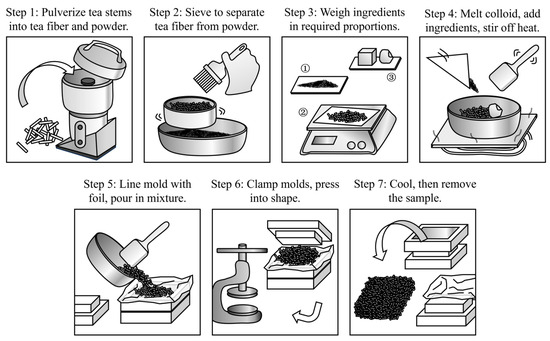
Figure A1.
Process of preparing tea waste experimental samples.
Appendix B
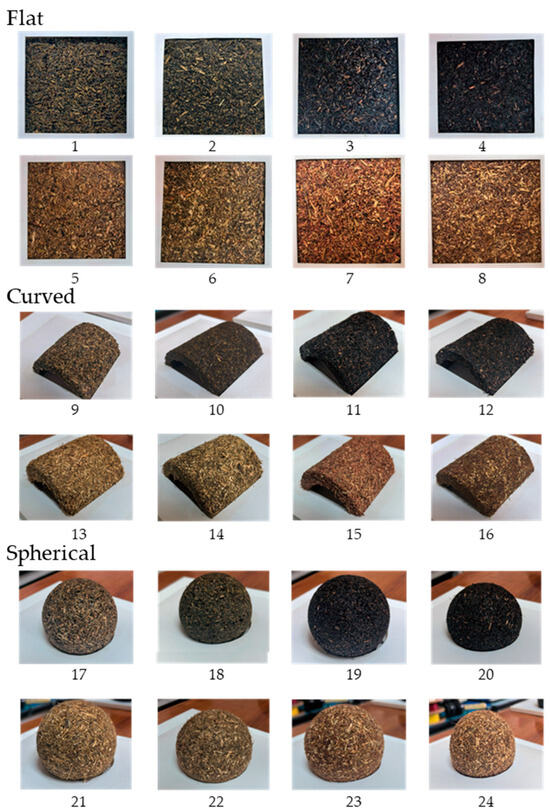
Figure A2.
Experimental sample pictures.
Appendix C

Table A1.
Classification results of tea waste experimental samples.
Table A1.
Classification results of tea waste experimental samples.
| Sample No. | Shape | Color | Intensity of Odor | Roughness |
|---|---|---|---|---|
| 1 | Flat | Green | Strong | Rough |
| 2 | Flat | Green | Strong | Smooth |
| 3 | Flat | Black | Medium | Slightly smooth |
| 4 | Flat | Black | Medium | Very smooth |
| 5 | Flat | Yellow | Light | Very rough |
| 6 | Flat | Yellow | Light | Slightly rough |
| 7 | Flat | Red | Light | Very rough |
| 8 | Flat | Red | Light | Slightly rough |
| 9 | Curved | Green | Strong | Rough |
| 10 | Curved | Green | Strong | Smooth |
| 11 | Curved | Black | Medium | Slightly smooth |
| 12 | Curved | Black | Medium | Very smooth |
| 13 | Curved | Yellow | Light | Very rough |
| 14 | Curved | Yellow | Light | Slightly rough |
| 15 | Curved | Red | Light | Very rough |
| 16 | Curved | Red | Light | Slightly rough |
| 17 | Spherical | Green | Strong | Rough |
| 18 | Spherical | Green | Strong | Smooth |
| 19 | Spherical | Black | Medium | Slightly smooth |
| 20 | Spherical | Black | Medium | Very smooth |
| 21 | Spherical | Yellow | Light | Very rough |
| 22 | Spherical | Yellow | Light | Slightly rough |
| 23 | Spherical | Red | Light | Very rough |
| 24 | Spherical | Red | Light | Slightly rough |
Appendix D
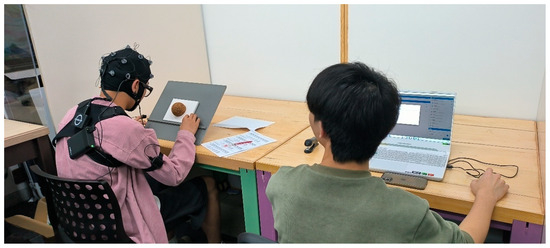
Figure A3.
Experimental site photos.
References
- Salazar Sandoval, S.; Amenábar, A.; Toledo, I.; Silva, N.; Contreras, P. Advances in the Sustainable Development of Biobased Materials Using Plant and Animal Waste as Raw Materials: A Review. Sustainability 2024, 16, 1073. [Google Scholar] [CrossRef]
- Furugori, E. Biobased Materials: Core Materials for the 21st Century, Interview with Professor Yoshiharu Kimura, Kyoto Institute of Technology. Macromolecule 2005, 54, 576–577. [Google Scholar] [CrossRef]
- Li, X.; Zhao, G. Construction of sustainable development system for furniture industry under dual-carbon strategy. Furnit. Inter. Decor. 2023, 30, 6–10. [Google Scholar] [CrossRef]
- Gao, P.; Zhang, Y.; Long, Z. Kansei Drives Sustainable Material Innovation—An Approach to Enhance the Added Value of Biobased materials. Sustainability 2024, 16, 5546. [Google Scholar] [CrossRef]
- Carus, M.; Dammer, L. The Circular Bioeconomy—Concepts, Opportunities, and Limitations. Ind. Biotechnol. 2018, 14, 83–91. [Google Scholar] [CrossRef]
- Nicolau, A.-M. Sustainable Perspectives Using Human Beings: The Sensory Properties of a Bio-Based Material Compared to a Synthetic Material—An Overall Assessment Based on an Innovative Blind Method. Sustainability 2023, 15, 9145. [Google Scholar] [CrossRef]
- Chen, S.G.; Li, Z.Z.; Ge, L.Z.; Zhang, Y.J.; Wang, C.H. Progress of Human Factors Engineering Research and Development Recommendations. China Sci. Found. 2021, 35, 203–212. [Google Scholar] [CrossRef]
- Desmet, P.; Hekkert, P. Framework of Product Experience. Int. J. Des. 2007, 1, 57–66. [Google Scholar]
- Bertheaux, C.; Zimmermann, E.; Gazel, M.; Delanoy, J.; Raimbaud, P.; Lavoué, G. Effect of Material Properties on Emotion: A Virtual Reality Study. Front. Hum. Neurosci. 2024, 17, 1301891. [Google Scholar] [CrossRef]
- D’Itria, E.; Colombi, C. Biobased Innovation as a Fashion and Textile Design Must: A European Perspective. Sustainability 2022, 14, 570. [Google Scholar] [CrossRef]
- Barrett, L.F.; Bar, M. See It with Feeling: Affective Predictions during Object Perception. Philos. Trans. R. Soc. B 2009, 364, 1325–1334. [Google Scholar] [CrossRef] [PubMed]
- MATLOVIČ, R.; MATLOVIČOVÁ, K. The Metamodern Shift in Geographical Thought: Oscillatory Ontology and Epistemology, Post-Disciplinary and Post-Paradigmatic Perspectives. Folia Geogr. 2025, 67, 22. [Google Scholar]
- Storm, J.A.J. Metamodernism: The Future of Theory; University of Chicago Press: Boston, MA, USA, 2021; ISBN 978-0-226-78679-7. [Google Scholar]
- Brosch, T.; Steg, L. Leveraging Emotion for Sustainable Action. One Earth 2021, 4, 1693–1703. [Google Scholar] [CrossRef]
- Karana, E.; Barati, B.; Rognoli, V.; Zeeuw Van Der Laan, A. Material Driven Design (MDD): A Method to Design for Material Experiences. Int. J. Des. 2015, 9, 35–54. [Google Scholar]
- Sauerwein, M.; Karana, E.; Rognoli, V. Revived Beauty: Research into Aesthetic Appreciation of Materials to Valorise Materials from Waste. Sustainability 2017, 9, 529. [Google Scholar] [CrossRef]
- Marschallek, B.E.; Löw, A.; Jacobsen, T. You Can Touch This! Brain Correlates of Aesthetic Processing of Active Fingertip Exploration of Material Surfaces. Neuropsychologia 2023, 182, 108520. [Google Scholar] [CrossRef]
- Fujisaki, W.; Tokita, M.; Kariya, K. Perception of the Material Properties of Wood Based on Vision, Audition, and Touch. Vis. Res. 2015, 109, 185–200. [Google Scholar] [CrossRef]
- Wang, L.; Qin, F. Research on aesthetic evaluation model of product CMF design. Packag. Eng. 2024, 45, 106–113. [Google Scholar] [CrossRef]
- Li, Y.; Liang, C.H.; Liu, X.L. Current status of perceptual engineering research in China and Japan and its revelation. Decor 2016, 92–95. [Google Scholar] [CrossRef]
- Suda, T. Fundamental Study on Texture Enhancement in Uncoated Plastics. Ph.D. Thesis, Chiba University, Chiba, Japan, 2015. [Google Scholar]
- Bradley, M.M.; Lang, P.J. Measuring Emotion: The Self-Assessment Manikin and the Semantic Differential. J. Behav. Ther. Exp. Psychiatry 1994, 25, 49–59. [Google Scholar] [CrossRef]
- Sorinas, J.; Ferrández, J.M.; Fernandez, E. Brain and Body Emotional Responses: Multimodal Approximation for Valence Classification. Sensors 2020, 20, 313. [Google Scholar] [CrossRef] [PubMed]
- Suhaimi, N.S.; Mountstephens, J.; Teo, J. EEG-Based Emotion Recognition: A State-of-the-Art Review of Current Trends and Opportunities. Comput. Intell. Neurosci. 2020, 2020, 8875426. [Google Scholar] [CrossRef]
- Xie, X.; Cai, J.; Fang, H.; Wang, B.; He, H.; Zhou, Y.; Xiao, Y.; Yamanaka, T.; Li, X. Affective Impressions Recognition under Different Colored Lights Based on Physiological Signals and Subjective Evaluation Method. Sensors 2023, 23, 5322. [Google Scholar] [CrossRef]
- Wang, J.; Lu, J.; Xu, Z.; Wang, X. When Lights Can Breathe: Investigating the Influences of Breathing Lights on Users’ Emotion. Int. J. Environ. Res. Public Health 2022, 19, 13205. [Google Scholar] [CrossRef]
- Gao, P.; Ogata, Y. CHAMU: An Effective Approach for Improving the Recycling of Tea Waste. IOP Conf. Ser. Mater. Sci. Eng. 2020, 711, 012024. [Google Scholar] [CrossRef]
- Gao, P.; Ogata, Y. Biodegradability of PLA and Tea Waste Composites Based on “CHAMU” and the “Tea Waste Recycling System”. IOP Conf. Ser. Mater. Sci. Eng. 2019, 563, 022034. [Google Scholar] [CrossRef]
- Gao, P. Tea Waste Sustainable Material Development and Furniture Design Applications. Furnit. Inter. Decor. 2023, 30, 50–55. [Google Scholar] [CrossRef]
- Guo, X.; Ho, C.-T.; Schwab, W.; Wan, X. Aroma Profiles of Green Tea Made with Fresh Tea Leaves Plucked in Summer. Food Chem. 2021, 363, 130328. [Google Scholar] [CrossRef]
- Du, B.; Chen, Y.; Li, Y.; Jiang, D.; Xia, Y.; Yang, G. Effects of Extruding Processing of Tieguanyin Tea Stem on Its Flavor and Aroma Components. Trans. Chin. Soc. Agric. Eng. 2010, 26, 381–384. [Google Scholar]
- Wu, W.; Jiang, X.; Zhu, Q.; Yuan, Y.; Chen, R.; Wang, W.; Liu, A.; Wu, C.; Ma, C.; Li, J. Metabonomics Analysis of the Flavor Characteristics of Wuyi Rock Tea (Rougui) with “Rock Flavor” and Microbial Contributions to the Flavor. Food Chem. 2024, 450, 139376. [Google Scholar] [CrossRef]
- Russell, J.A.; Weiss, A.; Mendelsohn, G.A. Affect Grid: A Single-Item Scale of Pleasure and Arousal. J. Personal. Soc. Psychol. 1989, 57, 493. [Google Scholar] [CrossRef]
- Chen, L.; Jiang, L.; Liu, B.; Chen, H.; Kang, G. Changes in somatosensory evoked potentials and electroencephalogram spectral characteristics after cerebral ischemia and their relation to apoptosis. China Crit. Care Emerg. Med. 2006, 268–271, 256. [Google Scholar]
- Agarwal, R.; Andujar, M.; Canavan, S. Classification of Emotions Using EEG Activity Associated with Different Areas of the Brain. Pattern Recognit. Lett. 2022, 162, 71–80. [Google Scholar] [CrossRef]
- Lin, Y.-P.; Yang, Y.-H.; Jung, T.-P. Fusion of Electroencephalographic Dynamics and Musical Contents for Estimating Emotional Responses in Music Listening. Front. Neurosci. 2014, 8, 94. [Google Scholar] [CrossRef]
- Davidson, R.J. Anterior Cerebral Asymmetry and the Nature of Emotion. Brain Cogn. 1992, 20, 125–151. [Google Scholar] [CrossRef]
- Fox, N.A. If It’s Not Left, It’s Right: Electroencephalograph Asymmetry and the Development of Emotion. Am. Psychol. 1991, 46, 863. [Google Scholar] [CrossRef]
- Al-Qazzaz, N.K.; Sabir, M.K.; Ali, S.H.B.M.; Ahmad, S.A.; Grammer, K. Electroencephalogram Profiles for Emotion Identification over the Brain Regions Using Spectral, Entropy and Temporal Biomarkers. Sensors 2019, 20, 59. [Google Scholar] [CrossRef]
- Alarcão, S.M.; Fonseca, M.J. Emotions Recognition Using EEG Signals: A Survey. IEEE Trans. Affect. Comput. 2019, 10, 374–393. [Google Scholar] [CrossRef]
- Galvão, F.; Alarcão, S.M.; Fonseca, M.J. Predicting Exact Valence and Arousal Values from EEG. Sensors 2021, 21, 3414. [Google Scholar] [CrossRef]
- Ge, Y.; Chen, Y.; Liu, Y.; Li, W.; Sun, X. Electrophysiological Measures Applied in User Experience Studies. Adv. Psychol. Sci. 2014, 22, 959. [Google Scholar] [CrossRef]
- Sánchez-Reolid, R.; López de la Rosa, F.; Sánchez-Reolid, D.; López, M.T.; Fernández-Caballero, A. Machine Learning Techniques for Arousal Classification from Electrodermal Activity: A Systematic Review. Sensors 2022, 22, 8886. [Google Scholar] [CrossRef] [PubMed]
- Harley, J.M.; Jarrell, A.; Lajoie, S.P. Emotion Regulation Tendencies, Achievement Emotions, and Physiological Arousal in a Medical Diagnostic Reasoning Simulation. Instr. Sci. 2019, 47, 151–180. [Google Scholar] [CrossRef]
- Buchanan, T.W.; Tranel, D. Central and Peripheral Nervous System Interactions: From Mind to Brain to Body. Int. J. Psychophysiol. 2009, 72, 1–4. [Google Scholar] [CrossRef]
- Hasnul, M.A.; Aziz, N.A.A.; Alelyani, S.; Mohana, M.; Aziz, A.A. Electrocardiogram-Based Emotion Recognition Systems and Their Applications in Healthcare—A Review. Sensors 2021, 21, 5015. [Google Scholar] [CrossRef]
- Lian, Z.; Guo, Y.; Cao, X.; Li, W. An Ear Wearable Device System for Facial Emotion Recognition Disorders. Front. Bioeng. Biotechnol. 2021, 9, 703048. [Google Scholar] [CrossRef]
- Wang, Y.; Lv, Z.; Zheng, Y. Automatic Emotion Perception Using Eye Movement Information for E-Healthcare Systems. Sensors 2018, 18, 2826. [Google Scholar] [CrossRef]
- McFarland, R.A. Relationship of Skin Temperature Changes to the Emotions Accompanying Music. Biofeedback Self-Regul. 1985, 10, 255–267. [Google Scholar] [CrossRef]
- Soleymani, M.; Lichtenauer, J.; Pun, T.; Pantic, M. A Multimodal Database for Affect Recognition and Implicit Tagging. IEEE Trans. Affect. Comput. 2012, 3, 42–55. [Google Scholar] [CrossRef]
- Russell, J.A. A Circumplex Model of Affect. J. Personal. Soc. Psychol. 1980, 39, 1161–1178. [Google Scholar] [CrossRef]
- Zampini, M.; Guest, S.; Spence, C. The Role of Auditory Cues in Modulating the Perception of Electric Toothbrushes. J. Dent. Res. 2003, 82, 929–932. [Google Scholar] [CrossRef]
- Iosifyan, M.; Korolkova, O. Emotions Associated with Different Textures during Touch. Conscious. Cogn. 2019, 71, 79–85. [Google Scholar] [CrossRef] [PubMed]
- Hama, H.; Mine, H.; Matsuyama, Y. Cross-Modality Validation of Affective Arousal by Texture. Jpn. Psychol. Res. 1982, 23, 196–202. [Google Scholar] [CrossRef]
- Lang, P.J.; Bradley, M.M. Emotion and the Motivational Brain. Biol. Psychol. 2010, 84, 437–450. [Google Scholar] [CrossRef]
- Jung, D.-H.; Han, K.-H. The Effect Of Shape On Emotion. Korea HCI Soc. 2007, 445–451. [Google Scholar]
- Wagemans, J.; Feldman, J.; Gepshtein, S.; Kimchi, R.; Pomerantz, J.R.; van der Helm, P.A.; van Leeuwen, C. A century of Gestalt psychology in visual perception: II. Conceptual and theoretical foundations. Psychol. Bull. 2012, 138, 1218–1252. [Google Scholar] [CrossRef]
- Wang, S.; Ding, R. A qualitative and quantitative study of color emotion using valence-arousal. Front. Comput. Sci. 2012, 6, 469–476. [Google Scholar] [CrossRef]
- Bestgen, A.-K.; Schulze, P.; Kuchinke, L. Odor Emotional Quality Predicts Odor Identification. Chem. Senses 2015, 40, 517–523. [Google Scholar] [CrossRef]
- Arzi, A.; Sobel, N. Olfactory perception as a compass for olfactory neural maps. Trends Cogn. Sci. 2011, 15, 537–545. [Google Scholar] [CrossRef]
- Kay, L.M. Circuit oscillations in odor perception and memory. Prog. Brain Res. 2014, 208, 223–251. [Google Scholar] [CrossRef]
- Johnson, K.O. The roles and functions of cutaneous mechanoreceptors. Curr. Opin. Neurobiol. 2001, 11, 455–461. [Google Scholar] [CrossRef]
- Suda, T.; Akiko, D.; Terauchi, F.; Mitsukutoku, K. Texture Expression by Composite of Silicone Resin and Filler. Des. Stud. 2015, 61, 85–92. [Google Scholar]
- Jensen, O.; Mazaheri, A. Shaping functional architecture by oscillatory alpha activity: Gating by inhibition. Front. Hum. Neurosci. 2010, 4, 186. [Google Scholar] [CrossRef] [PubMed]
- Headley, D.B.; Paré, D. In sync: Gamma oscillations and emotional memory. Front. Behav. Neurosci. 2013, 7, 170. [Google Scholar] [CrossRef]
- Helson, H.; Quantius, L. Changes in Skin Temperature Following Intense Stimulation. J. Exp. Psychol. 1934, 17, 20–35. [Google Scholar] [CrossRef]
- Kawai, S.; Takano, H.; Nakamura, K. Pupil Diameter Variation in Positive and Negative Emotions with Visual Stimulus. In Proceedings of the 2013 IEEE International Conference on Systems, Man, and Cybernetics, Manchester, UK, 13–16 October 2013; pp. 4179–4183. [Google Scholar] [CrossRef]
- Babiker, A.; Faye, I.; Malik, A. Pupillary Behavior in Positive and Negative Emotions. In Proceedings of the 2013 IEEE International Conference on Signal and Image Processing Applications, Melaka, Malaysia, 8–10 October 2013; pp. 379–383. [Google Scholar] [CrossRef]
Disclaimer/Publisher’s Note: The statements, opinions and data contained in all publications are solely those of the individual author(s) and contributor(s) and not of MDPI and/or the editor(s). MDPI and/or the editor(s) disclaim responsibility for any injury to people or property resulting from any ideas, methods, instructions or products referred to in the content. |
© 2025 by the authors. Licensee MDPI, Basel, Switzerland. This article is an open access article distributed under the terms and conditions of the Creative Commons Attribution (CC BY) license (https://creativecommons.org/licenses/by/4.0/).